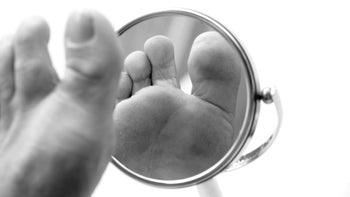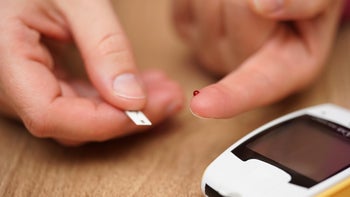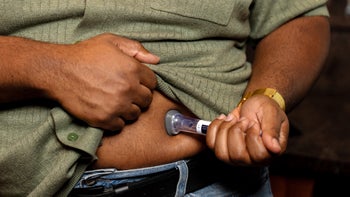
Hyperglycemia vs. Hypoglycemia: What’s the Difference?
Key takeaways:
The difference between hypoglycemia and hyperglycemia comes down to whether blood glucose (sugar) levels are too low (hypo) or too high (hyper).
Symptoms of low blood sugar and high blood sugar are different. With hypoglycemia, people can feel shaky, sweaty, and dizzy; but, with hyperglycemia, people often don’t experience any symptoms.
Recognizing the symptoms of hypoglycemia — and knowing how to treat it — is important when you have diabetes. Hypoglycemia that isn’t treated will get worse and can cause you to pass out or have a seizure.

Glucose (sugar) is the body’s main source of energy, which is why it’s important that blood sugar levels remain steady. Both hypoglycemia (low blood sugar) and hyperglycemia (high blood sugar) can be dangerous.
Because they are inverse conditions, hypoglycemia and hyperglycemia have different symptoms and treatments. And, with both, the symptoms differ from person to person. Some people may not experience symptoms at all.
Diabetes is the most common cause of both hypoglycemia and hyperglycemia. There are some other causes, but it’s pretty unusual for people who don’t have diabetes to have either one.
Save on popular GLP-1 Agonists
Take control of your health. With GoodRx, you may be eligible to save even more on popular treatments.

Hypoglycemia (low blood glucose)
Hypoglycemia, or low blood glucose, happens when the amount of sugar in your blood is too low. That’s a glucose level of less than 70 mg/dL on a glucose meter (glucometer), continuous glucose monitor (CGM), or other blood test.
If you have diabetes and you’re regularly getting readings under 70 mg/dL, or “hypos,” when you test your blood sugar, let your healthcare team know. They’ll look at your data and make adjustments to your treatment plan.
If your blood sugar is too low too often, your body can get used to it. This is dangerous because, over time, you may stop getting symptoms that alert you to your blood sugar being low. This is called hypoglycemia unawareness, which we’ll explore more below.
Causes of hypoglycemia
It’s uncommon for people who don’t have diabetes to have hypoglycemia. But, in rare cases, it can happen because of certain medications and medical issues, including:
Medications (insulin or other diabetes medications)
Excess alcohol consumption
Critical illness (sepsis and liver, kidney, or heart failure)
Malnourishment
Addison's disease
Tumor of the pancreas that produces insulin (insulinoma)
Non-islet cell tumor (a rare tumor that produces a hormone similar to insulin)
A complication of gastric bypass surgery
Diabetes is by far the most common cause of hypoglycemia. It’s most common in people with Type 1 diabetes, but it’s possible for those who have Type 2 diabetes or gestational diabetes to have it, too.
People who have diabetes have to constantly balance medications with food and exercise to keep blood glucose levels within a healthy range. That can be challenging, as every day is different. It’s not surprising that some days glucose levels run too low (or too high).
When you have diabetes, common causes of hypoglycemia include:
Too much exercise
Too much of any diabetes medication (insulin, sulfonylureas, glinides)
Illness
Skipped meals
Symptoms of hypoglycemia
Symptoms of hypoglycemia range from mild to severe and differ from person to person. It’s important to identify what hypoglycemia feels like for you, so that you can spot the warning signs early.
People may notice the following symptoms when their blood glucose level is below 70 mg/dL:
Sweatiness
Shaking
Dizziness
Confusion
Fast heartbeat
Hunger
Feeling weak or tired
Feeling nervous or upset
Headache
Will I notice if my blood sugar is low?
In many cases, yes, you will notice if your blood sugar is too low. But, as we discussed earlier, this isn’t always the case.
Some people with diabetes experience few or no symptoms with hypoglycemia. You might think that sounds good, but it’s not. Symptoms are the body’s way of alerting you to a problem, so that you can fix it.
When you don’t know that your blood glucose level is dangerously low, you don’t know to treat it. So it continues to drop, and you can become very confused, drowsy, pass out, or have a seizure.
Hypoglycemia unawareness affects about 40% of people who have diabetes.
How can I know if my blood sugar is low if I don’t notice any symptoms?
The best way to know what your blood glucose levels are is to test regularly with a glucometer, a small handheld device that you can use at home. Better yet, use a CGM, a wearable device that uses a sensor under the skin to measure glucose in the body’s tissues. Both devices will give you results in real time.
How can I treat low blood sugar?
You can treat hypoglycemia with fast-acting carbohydrates, using the “15-15 rule”:
Ingest 15 grams of fast-acting carbohydrates.
Wait 15 minutes.
Check your blood glucose level again. If it’s still below 70 mg/dL, repeat the cycle.
Carry sources of fast-acting carbohydrates with you at all times. Some examples of a 15-gram serving are:
4 glucose tablets
1 tube of glucose gel
1/2 cup of fruit juice or regular soda
6 large jelly beans
1 tablespoon of sugar or honey
How can I make sure my blood sugar doesn’t get too low?
Tracking how your own blood glucose levels change over the day with a glucometer or CGM is one of the best ways to prevent hypoglycemia. Understanding your personal patterns can help you predict when your levels might drop, such as during and after exercise. Then, you can take steps to stay ahead of it by making adjustments to your medication, exercise, or eating patterns.
You don’t have to do this alone. Your care team will help you to make adjustments to improve your time in range (TIR). TIR is the amount of time your blood glucose level is in your target range.
A common goal is a TIR of above 70%, or your blood glucose level being in target range 70% of the time or more. That’s at least 17 of the 24 hours in a day.
Hyperglycemia (high blood glucose)
Hyperglycemia, or high blood glucose, happens when the amount of sugar in your blood is too high. This can affect people who have diabetes and those who don’t. For those who have diabetes, high blood sugar is the main reason for long-term health complications related to the condition.
In general, glucose target ranges are as follows:
Without diabetes: For people who don’t have diabetes, a healthy target range is 70 mg/dL to 140 mg/dL.
With diabetes: People with diabetes typically have a target range of 70 mg/dL to 180 mg/dL.
These ranges can be different depending upon your overall health status, including any other medical conditions, and other factors. As an example, an older person with memory issues — who may not remember to check their blood glucose levels regularly or may not remember what to do if they run low — would have a target range designed to help avoid a dangerous low blood sugar situation.
Your healthcare provider will take all of these things into account before recommending a target range for you.
Causes of hyperglycemia
Like with hypoglycemia, it’s unusual for an otherwise healthy person to have hyperglycemia. For people who don’t have diabetes, an underlying medical issue or medication can cause hyperglycemia. Examples of these are:
Polycystic ovary syndrome (PCOS)
Certain medications, such as steroids
Diabetes is by far the most common cause of hyperglycemia. In fact, a high blood sugar level is the test that is used to diagnose diabetes. Diabetes treatment aims to keep glucose levels within a healthy range but, even with a good diabetes treatment plan, they can creep up.
Common reasons for hyperglycemia in people who have diabetes are:
Not taking enough diabetes medication
Eating more or exercising less than planned
Equipment issues with an insulin pump (kinked tubing or site, low battery, out of insulin)
Improperly stored medication (insulin or other medications not kept at a safe temperature)
An acute illness, like an infection
Stress
Hormone imbalances, such as during growth spurts, menstrual cycles, or menopause
Dehydration
Symptoms of hyperglycemia
As with hypoglycemia, symptoms of hyperglycemia range from mild to severe. They are also different for different people.
Common symptoms of hyperglycemia are:
Dry mouth
Increased thirst
Frequent urination
Headache
Blurry vision
Nausea
Feeling weak or tired
Shortness of breath
Fruity smelling breath
Vomiting
Flu-like symptoms, like feeling achy or unusually warm or cold
Will I notice if I have high blood sugar?
Some people are more sensitive to the symptoms of high blood sugar than others. Often, people can tolerate glucose levels that are just slightly out of range. But, as glucose levels get higher, symptoms often become more severe.
The easiest way to know your blood glucose level is to check it with a glucometer or CGM.
How can I keep my blood sugar from getting high?
Managing diabetes is a balancing act. If you have diabetes, you will most likely have high blood glucose levels now and again. (There is no being perfect when it comes to managing diabetes.) But, if your blood glucose levels are often higher than your target range or you’re noticing lots of ups and downs, it’s a sign you could use some extra help.
Here are some tips for keeping your blood glucose levels in range:
Take your medications as prescribed.
Keep active.
Follow a healthy diabetes eating plan.
Stay well-hydrated by drinking water.
See your healthcare provider if you’re feeling unwell.
What risks are associated with high blood sugar?
High blood sugar is the main cause of diabetes-related health complications. This is because, over time, high glucose levels cause damage to blood vessels, nerves, and vital organs like the kidneys, heart, and eyes. Hyperglycemia also affects your body’s ability to heal and fight infection.
But those aren’t the only risks. With diabetes, glucose builds up in the bloodstream, while the cells don’t get enough of it to fuel them. So the cells turn to other means of generating energy.
The body starts to break down fat, using the building blocks (ketones) as energy instead. As ketones build up in the body, it causes a life-threatening medical emergency called diabetic ketoacidosis (DKA). While anyone with diabetes can get DKA, it’s most common in people with Type 1.
Hypoglycemia vs. hyperglycemia: Is one worse than the other?
Both low blood glucose and high blood glucose can lead to life-threatening emergencies. This is why it’s important to recognize the signs early and know the difference. Left untreated, both hyperglycemia and hypoglycemia can worsen and be very dangerous.
Can a person have both hypoglycemia and hyperglycemia?
Yes, a person can have both high blood glucose and low blood glucose, but not at the same time. Blood glucose levels are always changing. Because of this, most people who have diabetes see their levels rise and fall throughout the day.
By using daily management tools, such as a glucometer or CGM, you can decrease out-of-range glucose levels and reduce the risk of diabetes-related health complications.
The bottom line
While hypoglycemia and hyperglycemia sound alike, they’re actually inverse problems, both of which can lead to serious health complications. These conditions are part of everyday life for most people who have diabetes. So, if you have diabetes, it’s important to know how to recognize and manage low blood sugar and high blood sugar.
If you’re finding it hard to keep your blood glucose levels within your target range, it’s time to talk to a healthcare provider. You may need to make adjustments to your equipment, medications, diet, or schedule. Often, increasing your TIR involves a careful balancing act, which you’ll become more skilled at over time.
Why trust our experts?


References
American Diabetes Association. (n.d.). Hyperglycemia (high blood glucose).
American Diabetes Association. (n.d.). Hypoglycemia (low blood glucose).
Association of Diabetes Care and Education Specialists. (2019). Managing low blood sugar.
Basile, L. M., et al. (2020). The link between PCOS and diabetes. Endocrine Web.
Colao, A., et al. (2013). Managing hyperglycemia in patients with Cushing’s disease treated with pasireotide: Medical expert recommendations. Pituitary.
Eckert-Norton, M., et al. (2013). Non-diabetic hypoglycemia. The Journal of Clinical Endocrinology and Metabolism.
Endocrine Society. (2022). Time-in-range and diabetes.
Farrokhi, F., et al. (2011). Glycemic control in non-diabetic critically ill patients. Best Practice & Research Clinical Endocrinology & Metabolism.
JDRF. (n.d.). Type 1 diabetes high blood sugar symptoms: Hyperglycemia symptoms.
Martín-Timón, I., et al. (2015). Mechanisms of hypoglycemia unawareness and implications in diabetic patients. World Journal of Diabetes
Murad, M. H., et al. (2009). Drug induced hypoglycemia: A systematic review. The Journal of Clinical Endocrinology and Metabolism.
National Institute of Diabetes and Digestive and Kidney Diseases. (2017). Continuous glucose monitoring.
National Institute of Diabetes and Digestive and Kidney Diseases. (2021). Low blood glucose (hypoglycemia).
Perez, H. E. T., et al. (2012). Glucose disturbances in non-diabetic patients receiving acute treatment with methylprednisolone pulses. Revista da Associacao Medica Brasileira.

























